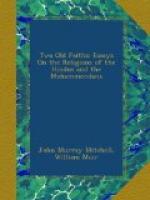The form which this philosophy ultimately assumed is well represented in the treatise called the Vedanta Sara, or essence of the Vedanta. A few extracts will suffice to exhibit its character. “The unity of the soul and God—this is the scope of all Vedanta treatises.” We have frequent references made to the “great saying,” Tat twam—that is, That art thou, or Thou art God; and Aham Brahma, that is, I am God. Again it is said, “The whole universe is God.” God is “existence (or more exactly an existent thing[15]), knowledge, and joy.” Knowledge, not a knower; joy, not one who rejoices.
[Sidenote: It teaches absolute idealism.] Every thing else has only a seeming existence, which is in consequence of ignorance (or illusion). Ignorance makes the soul think itself different from God; and it also “projects” the appearance of an external world.
“He who knows God becomes God.” “When He, the first and last, is discerned, one’s own acts are annihilated.”
Meditation, without distinction of subject and object, is the highest form of thought. It is a high attainment to say, “I am God;” but the consummation is when thought exists without an object.
There are four states of the soul—waking, dreaming, dreamless sleep, and the “fourth state,” or pure intelligence. The working-man is in dense ignorance; in sleep he is freed from part of this ignorance; in dreamless sleep he is freed from still more; but the consummation is when he attains something beyond this, which it seems cannot be explained, and is therefore called the fourth state.
[Sidenote: Doctrine of “the Self.” Inconsistent statements.] The name, which in later writings is most frequently given to the “one without a second,"[16] is Atman, which properly means self. Much is said of the way in which the self in each man is to recover, or discover, its unity with the supreme or real self. For as the one sun shining in the heavens is reflected, often in distorted images, in multitudes of vessels filled with water, so the one self is present in all human minds.[17] There is not—perhaps there could not be—consistency in the statements of the relation of the seeming to the real. In most of the older books a practical or conventional existence is admitted of the self in each man, but not a real existence. But when the conception is fully formulated the finite world is not admitted to exist save as a mere illusion. All phenomena are a play—a play without plot or purpose, which the absolute plays with itself.[18] This is surely transcendent transcendentalism. One regrets that speculation did not take one step more, and declare that the illusion was itself illusory. Then we should have gone round the circle, and returned to sensus communis. We must be pardoned if we seem to speak disrespectfully of such fantastic speculations; we desire rather to speak regretfully of the many generations of men which successively occupied themselves with such unprofitable dreams; for this kind of thought is traceable even from Vedic days. It is more fully developed in the Upanishads. In them occurs the classical sentence so frequently quoted in later literature, which declares that the absolute being is the “one [thing] without a second."[19]




